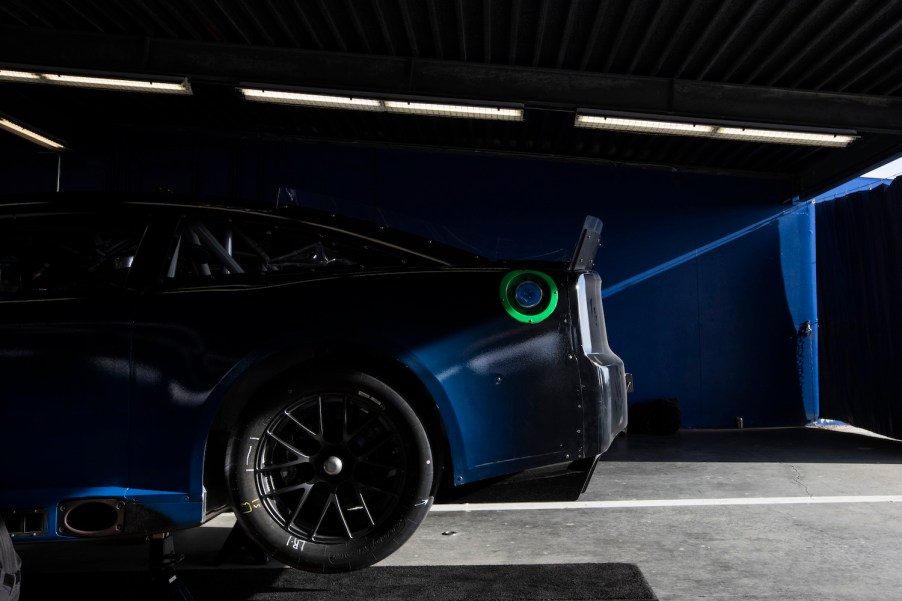
The Corvette-Style Next Gen Transaxle Transformed NASCAR
NASCAR’s Next Gen race cars debuted for the 2022 season. These cutting-edge stock cars feature a transaxle–a combination transmission and rear axle unit–similar in concept to the gearbox in the Chevrolet Corvette. The NASCAR Next Gen transaxle impacted how the new cars corner, shift, and pass. It even revolutionzed their aerodynamics.
A transaxle car’s weight is balanced

The first six generations of NASCAR stock cars featured a traditional front-engine, rear-wheel-drive layout. This layout placed a V8 motor and a manual transmission at the front of the vehicle and the drive axle at the back. The result is a front-heavy vehicle: the weight over the front wheels negatively affects the car’s handling.
Early sportscar engineers discovered they could better balance a front-engine car by moving the transmission to the back of the vehicle. They also found that combining the transmission and rear differential into a single unit saved weight overall.
Bugatti pioneered a front-engine car with a transaxle in 1929. In the 1950s, Lancia followed suit, then Ferrari in the 1960s, and Alfa Romeo in the 1970s. The Pontiac Tempest leveraged a transaxle layout from 1961 through 1963. In 1997, the Corvette converted to a transaxle layout, and Chevrolet has never looked back. Recent front-engine transaxle cars include the Cadillac XLR, Aston Martin DB9, and Mercedes Benz SLS AMG.
The new NASCAR Next Gen cars weigh just 3,200 pounds, 3,400 with driver and fuel. The transaxle drivetrain balances this weight between the front and back axles. This makes the NASCAR Next Gen cars much capable in the corners.
The NASCAR Next Gen transaxle will be a five-speed sequential manual

Since the 2022 season, all NASCAR Next Gen transaxles have been built by longtime NASCAR supplier Xtrac. The Xtrac P1334 is a five-speed (plus reverse) manual sequential transmission. Not only will it have one more gear than the outgoing transmission, but the gearshift lever will not move in the traditional “H” pattern. Instead, the floor-mounted gearshift lever will only move forward and backward.
Racers can pull the lever backward to shift their Next Gen car up a gear and push it forward to downshift. They can also lift the lever to disable the lockout and shift into reverse.
The NASCAR Next Gen cars will still have three pedals. But like the sixth-generation cars, drivers will likely only use the clutch to shift into first. Once moving, drivers usually match their next gear to their RPMs and shift without using their clutch.
NASCAR’s director of vehicle systems, Brandon Thomas, says the new transmission “will reduce shift times for the drivers who are bold enough and smooth enough to go after it.”
A full underwing improves NASCAR Next Gen aerodynamics

A transaxle housed in a solid rear axle would be too heavy to float over bumps in the road or imperfections in the pavement. For this reason, manufacturers attach transaxles to the car’s frame. The transaxle then drives two lightweight half-shafts, which in turn drive the wheels. This configuration means NASCAR’s Next Gen race cars benefit from the sport’s first full-length underwing.
The underwing evacuates air from beneath the Next Gen car. The underwing ends at diffusers built into the new car’s rear bumper–also a NASCAR first. The diffuser expels air and reduces turbulence. The resulting vehicle produces unprecedented downforce.
The increased downforce produced by NASCAR’s Next Gen racer allows the car to ride higher; the increased suspension travel makes it more stable when going over bumps or being jostled by other cars. This increased downforce also means the Next Gen cars can have symmetrical bodies yet maintain sixth-generation car speeds on the oval tracks while being more competitive on road courses.
One of the most important effects of the new underwing is the reduced turbulence. NASCAR Next Gen cars produce much less turbulence than their sixth-generation predecessors. This means it is much easier for NASCAR drivers to pass one another, and many fans believe racing has become more exciting.
NASCAR President Steve Phelps summed it up for MotorSport.com, “I think the racing is going to be better based on the aerodynamics of the vehicle.”
Not only will Next Gen cars, with their transaxle drivetrain, shift, and corner quicker, but they will pass more often. As a result, NASCAR is about to get a lot more exciting.
Next, read up on all the technologies that make the NASCAR Next Gen cars possible in our full series:
- NASCAR Next Gen Car Ultimate Guide
- NASCAR Next Gen V8 engines
- NASCAR Next Gen sequential shifter
- NASCAR Next Gen alloy rims and mono-lug
- NACAR Next Gen digital rearview mirror
Or you can see how the Next Gen cars’ transaxles work for yourself in the video below:






